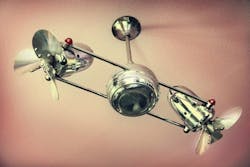To understand the amount of energy that goes into heating and cooling buildings, the GSA’s Green Proving Ground Program has taken on multiple projects to test technological innovations that reduce energy and water use. The program considered the energy effects of raising cooling setpoints and unsurprisingly found that it reduces energy usage while maintaining a comfortable working environment.
Related: Energy Saving Plan: Consider Occupant Comfort
On paper, raising cooling setpoints is a reliable way to save energy. Across the GSA-owned portfolio, 18.7 million kWh could be saved annually by simply raising setpoints by 2 degrees F. But maintaining comfortable working conditions with a higher cooling setpoint would require some additional mitigation to ensure proper temperatures. The smart ceiling fan is a possible solution that can allow for higher setpoints and energy savings while keeping buildings cooler.
A smart ceiling fan has sensors that measure temperature and will incrementally adjust fan speed to account for any changes. They turn on and off automatically based on occupancy or predetermined temperatures.
“Smart fans update a long-established technology, and have the potential to both save energy and offer comfort in today’s air tight buildings,” says Kevin Powell, Director of the Green Proving Ground Program.
And these supplements to occupant comfort significantly affect energy usage. In tests of smart ceiling fans, the National Renewable Energy Laboratory found that they can yield 4-11% energy savings with a 4-degree setpoint increase. Moreover, these savings are possible with an installed cost of less than $1.50/square foot for a payback in less than 10 years.
Smart Sensor Technology: Reducing HVAC Energy Use
Additionally, tests showed little indication that smart ceiling fans would perform differently based on location. Locations including Minneapolis, Miami, Phoenix and Seattle show similar energy saving capabilities despite vastly different climate demands.
In actuality, fans do not actually cool air themselves, but they help cool human skin by enhancing evaporation and convective heat transfer. What they really provide is comfort in slightly higher temperatures, which eases the workload of HVAC systems.
Where are these fans best deployed? Open offices can be the most useful locations for them, especially when the ceilings are at least 9 feet high and interior desk partitions are less than 54 inches tall in order to maximize the impact of the ceiling fan.
Other locations to target should have at least 2,000 cooling degree days and full daytime business hours. The cooling setpoint should also be lower than 75 degrees, and there should be no prohibitions against raising it.
Maximize Energy Savings with Lighting Controls
The downrod is another key component to the smart ceiling fan. Because a fan will provide greater wind chill effect when it is closer to occupants, fans that have longer downrods will typically be more effective. This is because fans that mount too close to the ceiling cannot as effectively bring air behind the blades to push down towards occupants. Blades should be no closer than 8 inches from the ceiling and 18 inches from the wall.
In terms of maintenance, the two types of motors in smart ceiling fans are important to note. There are those with sealed and lubricated ball bearings and those with bearings that rotate in an oil bath. The former will require little to no maintenance, compared to motors with oil baths that need occasional service to add oil, for example.
Features like lighting or air conditioning that will interfere with fan blades will not work. Ultimately, those interested in smart ceiling fans should consult with lighting engineers, designers and ceiling fan manufacturers to ensure that a fan works while not interfering with lighting or causing occupant discomfort.
Find out more about the options with smart ceiling fans by reading the white paper at www.gsa.gov.
Justin Feit ([email protected]) is Associate Editor for BUILDINGS.
